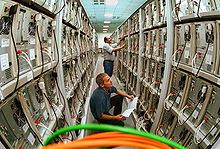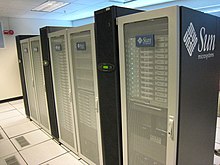
Back عنقود (حوسبة) Arabic Клъстер Bulgarian কম্পিউটার ক্লাস্টার Bengali/Bangla Clúster Catalan Počítačový cluster Czech Klyngecomputer Danish Rechnerverbund German Grapolo (komputado) Esperanto Clúster de computadoras Spanish Klaster (infotehnoloogia) Estonian



A computer cluster is a set of computers that work together so that they can be viewed as a single system. Unlike grid computers, computer clusters have each node set to perform the same task, controlled and scheduled by software. The newest manifestation of cluster computing is cloud computing.
The components of a cluster are usually connected to each other through fast local area networks, with each node (computer used as a server) running its own instance of an operating system. In most circumstances, all of the nodes use the same hardware[1][better source needed] and the same operating system, although in some setups (e.g. using Open Source Cluster Application Resources (OSCAR)), different operating systems can be used on each computer, or different hardware.[2]
Clusters are usually deployed to improve performance and availability over that of a single computer, while typically being much more cost-effective than single computers of comparable speed or availability.[3]
Computer clusters emerged as a result of the convergence of a number of computing trends including the availability of low-cost microprocessors, high-speed networks, and software for high-performance distributed computing.[citation needed] They have a wide range of applicability and deployment, ranging from small business clusters with a handful of nodes to some of the fastest supercomputers in the world such as IBM's Sequoia.[4] Prior to the advent of clusters, single-unit fault tolerant mainframes with modular redundancy were employed; but the lower upfront cost of clusters, and increased speed of network fabric has favoured the adoption of clusters. In contrast to high-reliability mainframes, clusters are cheaper to scale out, but also have increased complexity in error handling, as in clusters error modes are not opaque to running programs.[5]
- ^ "Cluster vs grid computing". Stack Overflow.
- ^ Bader, David; Pennington, Robert (May 2001). "Cluster Computing: Applications". Georgia Tech College of Computing. Archived from the original on 2007-12-21. Retrieved 2017-02-28.
- ^ "Nuclear weapons supercomputer reclaims world speed record for US". The Telegraph. 18 Jun 2012. Archived from the original on 2022-01-12. Retrieved 18 Jun 2012.
- ^ Gray, Jim; Rueter, Andreas (1993). Transaction processing : concepts and techniques. Morgan Kaufmann Publishers. ISBN 978-1558601901.
© MMXXIII Rich X Search. We shall prevail. All rights reserved. Rich X Search